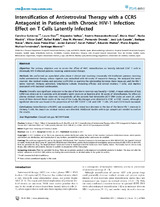Intensification of Antiretroviral Therapy with a CCR5 Antagonist in Patients with Chronic HIV-1 Infection: Effect on T Cells Latently Infected

Ver/
Autor
Muñoz Blanco, Eduardo
Gutiérrez, Carolina
Díaz, Laura
Vallejo, Alejandro
Hernández-Novoa, Beatriz
Abad, María
Madrid, Nadia
Dahl, Viktor
Rubio, Rafael
Moreno, Ana M.
Dronda, Fernando
Casado, José Luis
Navas, Enrique
Pérez-Elías, María Jesús
Zamora, Javier
Palmer, Sarah
Muñoz Blanco, Eduardo
Muñoz-Fernández, María Ángeles
Moreno, Santiago
Editor
Public Library Of Science (PLOS)Fecha
2011Materia
Antiretroviral therapyHIV-1
METS:
Mostrar el registro METSPREMIS:
Mostrar el registro PREMISMetadatos
Mostrar el registro completo del ítemResumen
Objective: The primary objective was to assess the effect of MVC intensification on latently infected CD4+ T cells in
chronically HIV-1-infected patients receiving antiretroviral therapy.
Methods: We performed an open-label pilot phase II clinical trial involving chronically HIV-1-infected patients receiving
stable antiretroviral therapy whose regimen was intensified with 48 weeks of maraviroc therapy. We analyzed the latent
reservoir, the residual viremia and episomal 2LTR DNA to examine the relationship between these measures and the HIV-1
latent reservoir, immune activation, lymphocyte subsets (including effector and central memory T cells), and markers
associated with bacterial translocation.
Results: Overall a non significant reduction in the size of the latent reservoir was found (p = 0.068). A mean reduction of 1.82
IUPM was observed in 4 patients with detectable latent reservoir at baseline after 48 weeks of intensification. No effect on
plasma residual viremia was observed. Unexpectedly, all the patients had detectable 2LTR DNA circles at week 24, while
none of them showed those circles at the end of the study. No changes were detected in CD4+ or CD8+ counts, although a
significant decrease was found in the proportion of HLA-DR+/CD38+ CD4+ and CD8+ T-cells. LPS and sCD14 levels increased.
Conclusions: Intensification with MVC was associated with a trend to a decrease in the size of the latent HIV-1 reservoir in
memory T cells. No impact on residual viremia was detected. Additional studies with larger samples are needed to confirm
the results.
